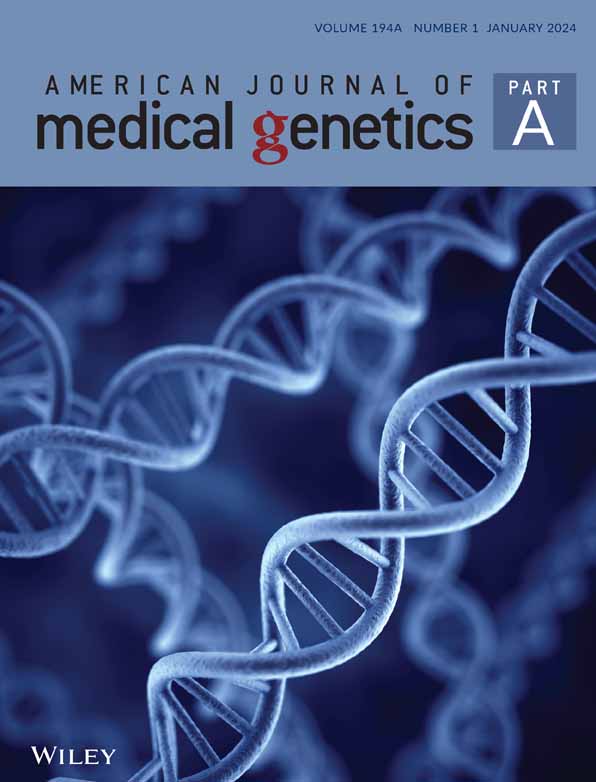Rule out compound heterozygous exonic/deep intronic ABCA4 variants in an MNGIE patient with Stargardt disease
We read with interest the article by Wang et al. (2023) who reported on a 33-year-old male with mitochondrial neurogastrointestinal encephalopathy (MNGIE) due to the pathogenic, homozygous variant c.1159+1G>A in TYMP (Wang et al., 2023). The patient also carried the heterozygous variant c.1561delG in ABCA4 (Wang et al., 2023). He manifested phenotypically with chronic diarrhea, severe weight loss, sensorimotor neuropathy, ptosis, ophthalmoparesis, retinopathy, hypoacusis, diabetes, lactic acidosis, steatosis, and coagulopathy (Wang et al., 2023). A detailed ophthalmologic examination revealed bilateral central scotomas due to loss of retinal ganglion cells (Wang et al., 2023). The study is excellent but has limitations that are cause of concerns and should be discussed.
The main limitation of the study is that the patient was not screened for intronic variants or deletions in the ABCA4 gene. Along with exonic ABCA4 variants, intronic variants have been reported to be responsible for hereditary, retinal dystrophy, also known as Stargardt disease (Bax et al., 2015). Stargardt disease is caused by homozygous or compound heterozygous variants in ABCA4. Although usually inherited in an autosomal recessive manner, heterozygous ABCA4 variants can be found in 18% of patients with Stargardt disease (Maugeri et al., 2000). Stargardt disease is phenotypically characterized by progressive deterioration of central vision (gray or hazy spots), photosensitivity, delayed adjustment between light and dark, color blindness, associated with irregular macular and perimacular yellow-white fundic patches (yellowish lipofuscin flecks in and under the macula, sometimes extending outward in a ring) resembling “beaten bronze” (Tsang & Sharma, 2018). Although Stargardt disease occurs predominantly in young adults, a late-onset form has also been described (Alsberge & Agarwal, 2022). An argument for a contribution of the ABCA4 variant is that several other MNGIE patients carrying TYMP variants had normal vision and normal fundus examination (Farahvash et al., 2021). Did the parents also have the ABCA4 variant? Have they been examined by an ophthalmologist?
A second limitation is that HbA1c levels were not reported (Wang et al., 2023). Knowing the quality of diabetes control is critical, as poorly controlled diabetes can be complicated by diabetic retinopathy. We should know whether the ophthalmologic findings can also be full or partially explained by diabetic retinopathy.
A third limitation is that leukoencephalopathy, characteristic of TYMP variants, has not been considered a cause of visual impairment. Since visually-evoked potentials (VEPs) could not be recorded, it cannot be ruled out that visual impairment was not only due to retinal anomalies but also to optic atrophy or impairment of the central visual pathways.
A neuropathy was described in the patient, which manifested as sensory disturbances and muscle weakness (Wang et al., 2023). However, the patient also had myopathy manifested by ptosis, ophthalmoparesis, and lactic acidosis (Wang et al., 2023). We should know if the limb muscle weakness was really due to neuropathy or rather to a myopathy involving the limb muscles. We should also know if levels of creatine-kinase lactate-dehydrogenase, aldolase and myoglobin, levels were elevated.
Overall, the interesting study has limitations that put the results and their interpretation into perspective. Addressing these issues would strengthen the conclusions and could improve the status of the study. Before a retinopathy can be assigned to the TYMP variant, alternative causes must be thoroughly ruled out. In particular, genome sequencing should be performed on carriers of exonic heterozygous ABCA4 variants to confirm or rule out compound heterozygosity with intronic variants. If not available, an assay could be designed to cover the intronic regions without requiring genome sequencing.
AUTHOR CONTRIBUTIONS
Josef Finsterer: Design, literature search, discussion, first draft, critical comments, final approval.
CONFLICT OF INTEREST STATEMENT
The author declares that the research was conducted in the absence of any commercial or financial relationships that could be construed as a potential conflict of interest.
INFORMED CONSENT
Written informed consent was obtained from the patient for publication of the details of their medical case and any accompanying images.
Open Research
DATA AVAILABILITY STATEMENT
Data that support the findings of the study are available from the corresponding author.




